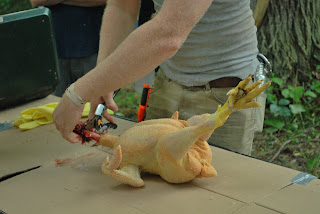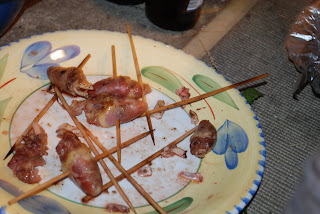
This entry is dedicated to Pop Pop Brugger, who passed away last night at the age of 87. In addition to cultivating a gorgeous, highly notable, and well-photographed garden every year in the town of Bethlehem, PA and making the most delectable peanut butter eggs at Easter, my grandfather made impeccable jellies. There is a story of him going to pick strawberries just a couple of years ago when his physically weakening body had just begun to significantly limit him. Of course hand-picking fruit is essential for the best jellies. So upon arriving at the U-pick, he asked some of the employees to help him to his knees, where he remained until he was finished picking. Though my preserves pale in comparison to his, I can only hope to honor him by carrying on the tradition.
-------------------------------------------------------------------------------------------------
Pop! Another jar assures me of a successful, spoilage-preventing seal. It’s night number two for canning just this week, and I’ll probably be preparing jars of jam again tomorrow night for the boiling bath. Later in the week, it’s the second round of tomatoes, maybe the last, for the season.
I just recently overcame my prohibitive apprehension of canning. Passive-aggressive germophobia previously deterred me from preserving produce in any other way than freezing. Of course last year I also wanted to spend minimal time handling fruits and veggies outside of farm work, but that was just an easy cover. In my mind, I considered a long list of hazards that would most definitely result in my contraction of—and eventual death from—the surreptitious pathogen that is botulism: non-sterile fruit, non-sterile countertops, non-sterile jars and lids, non-sterile canner, non-sterile air. And what if I did something wrong? What if the jars weren’t hot enough when I poured the ingredients? What if I didn’t remove all of the air bubbles? What if I didn’t screw the lids on fast enough after filling the jars?
I worried myself out of time and stored my newly purchased canner for winter, having never filled it with water.
It would have to be different this season—there simply isn’t enough freezer space. After consulting experienced canners about their method, I was convinced that the books telling me to use only flawless produce harvested THAT day (highly unlikely) and to process quarts of whole tomatoes for 85 minutes were perhaps simply covering their asses. A friend in Italy vividly described the old country way of canning tomatoes with large, open barrels sitting over fires. Was the Italian peasantry worried about a precisely even cooking surface or scraping every germ from the countertop? Of course not. I even came across a website that said that if you can boil water, you can can.
I disregarded all reservations and, enlisting Dylan, peeled and quartered some peaches. Taking our time, we filled the jars with the fruit and a light syrup, screwed on the lids, processed in boiling water for the prescribed time, then counted 6 pops after taking them out of the water: success! Now that I know how easy it is, I’m rolling like the boil, canning at least once a week during the past month.
Of course, I should be careful. I’m toying with a balance, and perhaps nearing the point when a heavier sense of duty plops on the seesaw, thrusting oh-so-light pleasure into a sphere of no return. My boss Jack, in his subtle way, warned me: “It takes a lot of time and energy. I used to take off work when I was younger to can until I wore myself out. Then I decided I wasn’t going to be a slave to my produce—if I grew it, I don’t have to feel guilty about letting it go and compost in the ground.”
His preservation philosophy makes sense, but right now I don’t have the luxury of losing a few dollars to rot or feed for the growing population of fruit flies in the kitchen. Most of our vegetables are free, but fruit is relatively expensive. And now is the time to ensure an adequate supply of local food for the long winter to come (as though I couldn’t possibly go to a store and buy food).
So here I am, on a Wednesday night, canning until 11:30 for the second time in a row. (Weekends are too busy, and that’s when I get the ingredients). I’d just begun Round Three of processing, having transitioned from easy-peasy peaches to a plum-honey preserves recipe. I needed to get through the plums since they’d been in the fridge for three days and were softening. But after a long day at the office and a late start in the kitchen, I was tired.
I paused from the tedious pitting and quartering of plums over a pot and looked at the clock. 10:30. All of this for two half-pints. A sigh. This is stupid, I let myself think. But I was too far along now to stop. I pushed on, finished the chunking, added the honey, and brought the contents to a boil.
What happened next was one of those rare moments in the kitchen when a right-minded person bows in adoration to the magic of chemistry and physics: Though I knew the heat would reduce the fruit, I could have never anticipated the royal color and aroma that arose. The plum skins bled garnet as pulp and liquid sugar fused with the transcendent aroma of harmony. I inhaled fervently over the rapidly boiling potion, now thinning into a translucent fuschia, lusting for a description that would do such godliness justice. You think I’m taking this is a bit far? No. The intoxicating smell transported me to a garden of waking roses, plumeria, and honeysuckle, ripe with dew.
Could I seriously be talking about jam? Yes.
Even Dylan—who claims to not love jams and jellies—widened his eyes with his first taste-test, saying, “Wow. That’s really good.” I hadn’t eaten dinner, but after indulging in my own spoonful, I sank with pleasure, which I surely would have missed had I simply purchased some plum preserves from the store.
I’m probably in for another five hours of processing tomatoes this weekend. But when I use the last jar to make the family sauce come February or March—with four months to go until tomatoes start ripening on local vines again—I’ll wish I’d done more.
PLUM HONEY PRESERVES
Adapted from Preserving Summer's Bounty, A Rodale Garden Book
Yield: Two half-pints
16 medium red or purple plums, slightly under-ripe if possible
1 cup mild-flavored honey (I used rich buckwheat, but it still turned out wonderfully)
1. Use a heavy-bottomed, 6- to 8-quart enamel or stainless steel pot, preferably one that is wider than deep. Pit the plums, and cut them into large chunks (no need to peel), working over the pot to catch the juices. Stir in the honey. Bring to a boil over low heat, stirring frequently.
2. When the mixture looks soupy, raise the heat and bring to a full, rolling boil. Skim off the solid white foam. Continue to stir slowly for 15-20 minutes. It will thicken further as it cools.
3. To can: Pour into hot, scalded half-pint jars, leaving 1/4-inch headspace. Seal and process for 10 minutes in a boiling-water bath.










